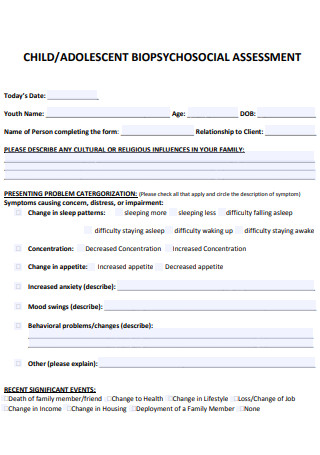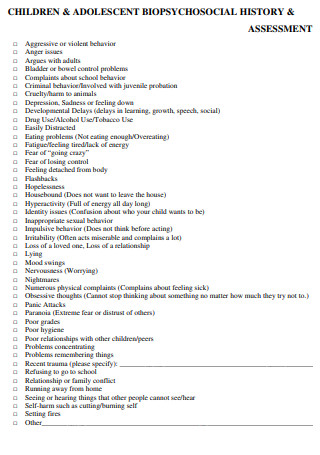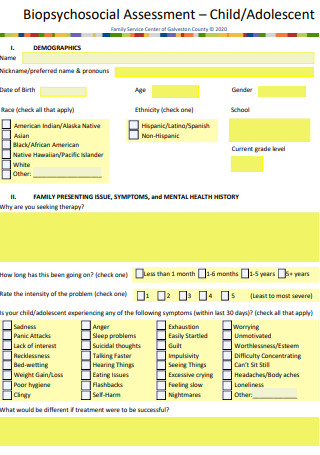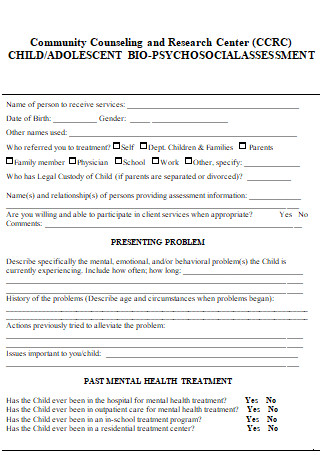3+ SAMPLE Child Biopsychosocial Assessment
FREE Child Biopsychosocial Assessment s to Download
3+ SAMPLE Child Biopsychosocial Assessment
What is a Child Biopsychosocial Assessment?
Different Stages of Biopsychosocial Assessment
Basic Elements of a Child Biopsychosocial Assessment
How to Write a Child Biopsychosocial Assessment
FAQs
What are some examples of biopsychosocial approaches?
What is the purpose of a child biopsychosocial assessment report?
What are the different stages of the child assessment cycle?
What are the essential basic guidelines to follow during child assessment?
What is a Child Biopsychosocial Assessment?
A child biopsychosocial assessment is a well-detailed document designed to provide a clear analysis or evaluation of a child’s biological, social and psychological factors as these crucial aspects are all intertwined and influence their overall well-being Being used by mental health professionals, this is a fundamental assessment which outlines the needs of a child who might have a mental illness that can greatly impact their social and physical wellness.
According to a 2020 study conducted by Dubey and other researchers, strict worldwide quarantine measurements implemented due to the COVID-19 pandemic have raised concerns regarding the consequences on mental health which may lead to anxiety, stress, hysteria, and distress. Experts and other professionals in mental health should create a clear and well-detailed child biopsychosocial assessment to recognize the need to observe their child or adolescent patients holistically and consider other aspects of their lives that might greatly contribute to their mental health problems.
Different Stages of Biopsychosocial Assessment
George Engel is the one who proposed the framework called biopsychosocial model of illness. With this, the psychiatrist tries to comprehend the patient in biological, psychological, and social terms simultaneously, or arrive at a holistic picture with multiple strategies for treatment. The book Models of the Mind: A Framework for Biopsychosocial Psychiatry stated that in order to accommodate the diversity of problems, it is important to shift the models of the mind. But, what are the different types of methods in using biopsychosocial assessment? In this part, you will learn and understand about the different stages of biopsychosocial assessment. We will introduce and explain to you about them below:
Stage 1: Case Finding
Also known as the “Child-Find” stage, case finding is the beginning stage of the biopsychosocial assessment which is established to search for those young children or teens who might need early intervention services and programs. There are many parents or guardians who are not aware about the services provided for young children or teens, as they may not realize that their child experiences a particular developmental issue. Or perhaps the family may ignore an issue that exists due to their strong cultural beliefs and traditions. To locate young children or teens in the community who may need biopsychosocial services, it is essential to build community awareness through public agencies, institutions and organizations, to develop a specific system for referrals, to inspect the community for young children or teens who need screening and to keep local publicity and contacts with referral sources.
Stage 2: Developmental Screening
The cursory method for acquiring general information about a child’s development as well as in discovering any potential problems is developmental screening. Mental health professionals don’t use this method for comprehensive diagnosis but it is necessary so that they are able to have a first quick look at the child’s current condition. Typically used with large groups of children, the screening procedures and tests should be brief, inexpensive, and provide valid and reliable objective scoring systems. Families should discern the main purpose of screening procedures and be knowledgeable concerning the outcomes. When the developmental screening determines that a child has possible issues, it is integral that the child obtains a further in-depth diagnosis.
Stage 3: Comprehensive Diagnosis
This stage is called a comprehensive diagnosis which means it is an in-depth evaluation or assessment because the data will come from careful observation, interviews, case history, and informal and standardized tests. The evaluators should try their best in identifying the nature of the child’s difficulties, the severity of the problem, as well as the strengths and weaknesses of the child. In order to successfully perform a comprehensive diagnosis, the members of a multidisciplinary team might perform something to diagnose the needs of the child. For instance, they may include a speech or language pathologist or an audiologist or otologist to examine the hearing loss with the addition of a psychologist to figure out how the development of the child is linked to language acquisition if the child has shown some language difficulties. The information gathered through the comprehensive diagnosis leads to worthwhile decisions concerning the nature and severity of the child’s problem which can be used in planning of specific programs and interventions.
Stage 4: Effective Planning of Programs and Interventions
After the comprehensive diagnosis, the fourth stage involves biopsychosocial assessment for effective planning or programs and interventions. Curriculum-based or criterion-referenced instruments and procedures are utilized to connect this stage of the biopsychosocial assessment to the actual curricula of the child’s early intervention program. Cognitive abilities, sensory or physical development, adaptive or self-help skills, fine and gross motor development, language and communication abilities and social-emotional development are the essential areas that mental health experts should consider when it comes to the planning process for young children.
Stage 5: Intervention Program Monitoring
It is integral that the progress or development of the child is closely monitored frequently after the child is placed in an intervention program. Constant observations, progress checklists and rating scales are used to check the present condition of the child continuously. As a medical expert in mental health and psychotherapy, it is essential to collect data on a regular basis and analyze them to identify mastery of targeted skills or abilities. Plus, indicate the overall progress when it comes to reaching specific goals and objectives on the Individualized Education Plan (IEP) of the child or Individualized Family Service Plan (IFSP). Look back on the overall intervention program designed for the child and know if the intervention program is effective. If you notice that the program lacks something, make some necessary changes in the intervention program.
Stage 6: Careful Evaluation of the Intervention Program
Steven Redhead said: “Careful evaluation of information that is portrayed as fact is critical.” Thus, it is very crucial to make a careful evaluation of the intervention program. You can do this by determining the children’s progress and the effectiveness of the overall intervention program. As an objective and systematic procedure, it is important to perform critical changes and alterations in the intervention program.
Basic Elements of a Child Biopsychosocial Assessment
In this section, you will learn how to construct a remarkably written and well-detailed child biopsychosocial assessment. However, a child biopsychosocial assessment has different aspects to consider. Include the following elements for you to create an excellent document:
How to Write a Child Biopsychosocial Assessment
Children and teenagers may experience a wide spectrum of results following disasters of all types and unpredictable events like the COVID-19 pandemic and only a small percentage of children and youth will develop mental and/or substance drug use disorders after the disasters and difficult situations. However, writing a child biopsychosocial assessment is required for children who often regress after a disaster as they tend to lose their skills and abilities prior to the disaster or returning to certain behaviors they had outgrown. Below are some easy-to-follow tips that indicate how to design and create a professional child biopsychosocial assessment:
Step 1: Identify the Biological, Psychological and Social Problems and Needs of the Child
Conduct a simple and effective screening of the child so that you are able to observe the current condition of the child. Identify the potential issues and needs of the child in various factors such as in biological, psychological and social aspects. This will help you to assess his or her needs, and to diagnose and treat the condition he or she is experiencing during these challenging times.
Step 2: Provide the Basic Information, Historical Records, and Current Status
The second step is to provide the basic information, historical records and the current status of the child. You need to indicate the primary information including the full name, gender, and date of birth of the child. Depict the problem of the child as you describe the issue. Then, describe the family members of the child, educational background, religious beliefs, current and past medical background, etc.
Step 3: Collect and Analyze the Data
Review the documents on the current biopsychosocial assessment and compile additional information of the intervention program so that you are able to understand and utilize the latest knowledge, insight, and experiences on the areas of the reconstruction in the intervention program.
Step 4: Write the Critical Assessment
Now is the appropriate time to write your critical assessment of the child’s biopsychosocial condition. Prepare a short summary of the patient’s primary problem and other factors influencing his or her condition. Describe the appearance and mood of your patient, as well as indicate your impression of the child’s current health condition.
Step 5: Proofread and Revise the Report If Necessary
Double-check your overall child biopsychosocial assessment from time to time. Write all the crucial elements in your child biopsychosocial assessment report. If you notice that you overlook some sections that need further points, we suggest that you proofread and revise the document in an organized manner.
Step 6: Prepare the Final Child Biopsychosocial Assessment
After the proofreading and revision process, you can now prepare the final child biopsychosocial assessment. Include some notes and other fundamental advice and other instructions you want to convey to the parents or guardian of the child on the concluding part of the child biopsychosocial assessment. Skim your assessment for final evaluation and quality check.
FAQs
What are some examples of biopsychosocial approaches?
Some examples of biopsychosocial approaches are that an individual may have a genetic predisposition for depression but they must have social factors like extreme stress at work, family life, and psychological factors like being perfectionist, and a person may have a genetic predisposition for a particular disease due to the cognitive and social factors that triggered the illness.
What is the purpose of a child biopsychosocial assessment report?
The purpose of a child biopsychosocial assessment report is to assess the skills, and abilities of a child who is currently experiencing a problem, as well as measuring the overall performance of an intervention program. This is important in forming worthwhile decisions and designing plans for the children who are struggling in these trying times.
What are the different stages of the child assessment cycle?
The different stages of the child assessment cycle are case finding, developmental screening, comprehensive diagnosis, effective planning or programs and interventions, intervention program monitoring, and careful evaluation of the intervention program.
What are the essential basic guidelines to follow during child assessment?
The essential basic guidelines or areas during child assessment are basic care, guaranteeing safety, emotional warmth, guidance and boundaries, stability and stimulation.
Therefore, writing a clear and effective training child biopsychosocial assessment is an essential process in assessing the main problems and needs of the child in various factors such as in biological, psychological and social aspects. Plus, this child biopsychosocial assessment acts as a useful guide for mental health experts and psychotherapists or psychiatrists to diagnose, interpret, and communicate outcomes to the parents, guardians, managers, or teachers of the child. This is very helpful especially during this COVID-19 pandemic that brings an enormous impact on the biopsychosocial health of many people, particularly on young people. So, here are some of our downloadable and printable child biopsychosocial assessment report samples available in different kinds of formats. Simply click the child biopsychosocial assessment templates in this article and start downloading now!




